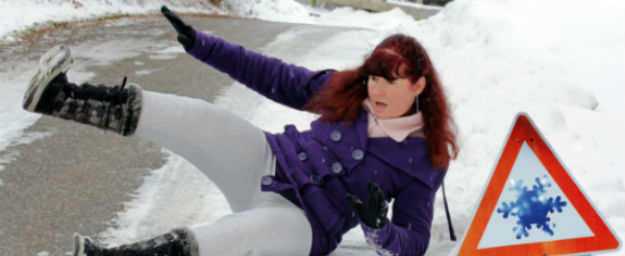
Stay on Your Feet This Winter
Falls due to winter conditions are a safety issue but it is important to note that they are also a healthcare issue. This is because the consequences of a fall can be serious, and in the case of the elderly a fall can lead to a loss of independence. The grim truth is that for older adults some falls ultimately lead to death, which we may call fall-related death. The risk of fall-related death increases dramatically after the age of 65. While women are at a greater risk of non-fatal falls, men are at greater risk of a fatal fall. The higher rate of fall-related deaths in men may be more a result of complicating health issues at the time of the fall rather than the severity of the fall itself.
Individuals under the age of 65 are not immune to falls or fall-related injuries. While younger individuals seldom fracture a bone, they can often experience muscle strains or back injuries. These injuries happen when the individual slips and, to stay vertical, jerk their body or quickly reach out to grab hold of a solid object.
Perhaps the most important defense against falls is awareness. Reminding yourself that slippery hazards are to be expected all winter and that walking outdoors may require shorter, slower steps. The fact that 56 percent of all falls occur outside of the home highlights the need to be mindful of the extra hazards in winter. Good fall prevention can mean strategically planning your route in and out of buildings based on the location of ice and snow hazards. Also, consider that some ice, the dreaded clear “black ice” for example, can be quite hard to see or lurks under a fine dusting of snow. Likewise, the short winter days mean there is little sunshine to light our way. We sometimes have to cross slippery surfaces in the dark. A keychain flashlight can be handy tool to spot any ice in your path.
Falls can also be prevented where the rubber meets the road. In other words, by choosing the appropriate footwear. Rubberized soles with a traction pattern can help keep you stable on snow or slush covered surfaces. If you often need to walk through slippery, ice-prone areas consider augmenting your existing grip with spikes or treads that pull over the sole.
The increased risks of winter falls are a concern for everyone but, as mentioned, older adults are particularly vulnerable. One quarter of Americans over the age of 65 falls once a year and it is no surprise that the incidence of falls among older adults increases in the winter. Falls are the leading cause of accidental death in those older than 75. A hip fracture, which occurs in one to two percent of falls, is the number one reason for fall-related hospital stays. Of those individuals who suffer a hip fracture, half must be discharged from the hospital to a nursing home and one quarter die. Here are some known risk factors for falls:
- Greater than 75 years of age
- Living alone
- Prescription drug use – especially the use of multiple drugs
- Use of a cane or walker
- Cognitive impairment
- A history of falling
- Poor vision
- Poor hearing
- Foot problems – such as the type that occur with diabetes
- Environmental hazards (such as snow and ice)
Winter is known for throwing slippery obstacles in our path. Prepare yourself and avoid potentially serious fall-related injuries. If you are at risk of falling or lack confidence outdoors in the winter, see your doctor or physical therapist. These healthcare providers can screen your balance, help you make balance improvements and reduce your risk of a serious fall-related injury.
SOURCES
https://www.osha.gov/dts/weather/winter_weather/hazards_precautions.html#walking
http://www.sciencedirect.com/science/article/pii/S2210833511000050
https://www.ncbi.nlm.nih.gov/pmc/articles/PMC2686332/
http://www.who.int/ageing/projects/1.Epidemiology%20of%20falls%20in%20older%20age.pdf
Yeung, P.-Y., Chau, P.-H., Woo, J., Yim, V. W.-T., & Rainer, T. H. (2011). Higher incidence of falls in winter among older people in Hong Kong. Journal of Clinical Gerontology and Geriatrics, 2(1), 13–16. doi:10.1016/j.jcgg.2011.02.002 -disease



